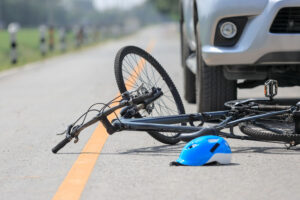Bicycling is a significant hobby, form of exercise, and method of transportation for millions of Americans. However, because the use of bicycles is constantly growing, the number of accidents is, too. It only takes one wrong move to lead to injuries and fatalities.
Bicyclists are exposed continuously and are more susceptible to accidents. Motorists always need to be vigilant and take extra caution with bicyclists. Because of the dynamic of the bicycle and the lack of protection, they have, many different types of accidents can occur so call our skilled bicycle accident attorney for legal help.
Bicycle Accidents in The United States
Unfortunately, many motorists need to take the time to be careful as they pass by bicyclists. Some do not look out for them, so accidents are bound to occur. In a nation where almost 50 million people ride bikes daily, vehicles must be more careful than ever not to hit or get in their way.
Many distractions, such as eating, using their cellphone, and being drowsy, cause motorists to swerve and not give the road their full attention. In a recent year, 932 persons died in car-bicycle accidents, which only keeps increasing yearly.
Many drivers also do not know how to correctly yield to bicyclists, the second-most common cause of accidents. Many don’t know (or do not care to obey) the law in all states of maintaining at least three feet between them and the bicyclist. Seventy-nine percent of bicyclist deaths happen in urban areas and 32 percent at intersections. Intoxication, driver fatigue, missing blind spots, and aggressive driving cause many of these accidents.
Dooring Collision
Dooring accidents occur when bicyclists crash into a motor vehicle’s open door, causing them to sometimes fly entirely over it. These commonly occur in heavily populated areas, such as downtowns and cities where many tourists visit. These often happen because the vehicle operator fails to check before opening their door. A bicyclist going even at their average speed of 10 to 15 miles per hour can crash hard into a car door, possibly causing severe injuries.
Dooring injuries are common to the head, face, and upper body, as those are the parts of the cyclist that often directly hit the door. Additional injuries might occur if the cyclist falls forcefully backward onto the pavement, as they might suffer head or spinal trauma, among many other traumatic injuries.
A vehicle operator might also have left the door wide open while they went to get something from the other side, causing the bicyclist to swerve quickly out of the way. If there was not enough time to react in this situation, that bicyclist might have had no choice but to deviate right into oncoming traffic and get seriously hurt.
In many states, dooring is such an issue that rules are in place about how drivers should open their doors. For instance, they are to constantly double-check if a bicyclist is coming by, and the best way to do this is by using the “Dutch Reach,” where the driver takes their hand furthest from the car door and uses that one to open it. So, if it’s a driver in the U.S., they will take their right hand to open the car door instead, which obligates them to turn around.
Right Hook Collision
Sometimes, when a vehicle passes the bicyclist and comes up to an intersection where they’re going to make a right, a proper hook collision occurs. This accident occurs when the bicyclist crashes head-on with the vehicle because the operator does not see that the bicyclist is also trying to turn or continue forward.
Many cars and trucks will pass bicyclists and turn anyway because they do not see them or do not check to see if any bicyclist is coming. Motorists should always check their mirrors to ensure that all is clear to make the right turn.
Many right hook accidents happen without warning. Forty-eight percent of motorists do not use turn signals when changing lanes. This sudden change can catch the biker off guard and not give them enough time to stop or slow down. Along with the excessive speeds at which some motorists turn, it can lead to catastrophic injuries or death for the bicyclist.
Uncontrolled Intersection Collision
An uncontrolled intersection does not have any lights or signals. These are found mainly in rural areas, but bicycle accidents can still occur in these intersections despite low population levels.
At an uncontrolled intersection, the right-of-way always goes to the one that reaches the line first. However, many motorists need to understand this rule also applies to bicyclists. Instead, they assume the bikers will always stop or wait for the car to pass first. Vehicle operators sometimes do not realize that bicyclists are vehicles, too.
Irresponsible motorists cause these collisions by not checking to ensure no bicyclists are at the intersection. There might have potentially been some blind spots for the motorist, but they should always verify that the coast is clear before they cross.
Red Light or Stop Sign Collision
Many motorists must learn all the rules regarding red lights and stop signs with bicyclists. Many do not see bicyclists as vehicles (they should), so they don’t give them the right-of-way when it’s their turn. With even the slightest bit of distraction at a red light or stop sign and believing they can move forward, the motorist can crash into the bicyclist, leading to injuries or possibly even death for the cyclist.
In several states, what’s called a Bicycle Stop Law exists. This law applies where bicyclists can treat stop signs and red lights as if they were yield signs. They do not have to make a complete stop and wait for their turn to go. If they are at a red light, they can proceed so long as no vehicle is crossing through. This law can lead to more bicycle-car accidents because many motorists might not be aware that they can do this, so they will not stop to look twice for bicyclists.
Right Cross Collision
This type of collision is widespread. A right cross collision occurs when a driver pulls out of a driveway, parking lot, or side street where it’s difficult to see if there are any oncoming bicyclists or pedestrians. Since this will appear very sudden to the bicyclist trying to cross, they will need more time to react accordingly. The bicyclist gets struck directly by the car or crashes into the car’s side, depending on how fast they are both going.
Left Cross Collision
 A left-cross collision is essentially the opposite of a right-cross and just as widespread and preventable. This accident happens when an oncoming vehicle is going to make a left turn but doesn’t notice the bicyclist is in the lane next to them. They then cross over the right lane where the bicyclist is traveling and strike them directly. It can happen anywhere the cyclist is next to them on the left, such as outside garages, crossroads, driveways, and parkways. It can also happen when the bicyclist is riding on the sidewalk.
A left-cross collision is essentially the opposite of a right-cross and just as widespread and preventable. This accident happens when an oncoming vehicle is going to make a left turn but doesn’t notice the bicyclist is in the lane next to them. They then cross over the right lane where the bicyclist is traveling and strike them directly. It can happen anywhere the cyclist is next to them on the left, such as outside garages, crossroads, driveways, and parkways. It can also happen when the bicyclist is riding on the sidewalk.
Rear-End Collision
In several studies, rear-end collisions appear to be the most common type of car-bicycle accident. For instance, according to the League of American Bicyclists, approximately 40 percent of fatalities reported were rear-ended collisions. Rear-end collisions are prevalent because several different situations and factors can lead to them. A bicyclist might come across a pothole in their lane and try to avoid it, leading to them swerving hard to their left. An oncoming vehicle might not react to this right away and can hit them directly.
They can also happen when motorists drive too close behind or next to the bicyclist. Perhaps they’re an aggressive driver and cannot pass the bicyclist, so they get close behind them as a classic tactic to try to get the bicyclist to speed up or move out of the way. Any obstruction in front of the bicyclist, like debris on the road, can lead to them having to suddenly brake quickly, causing the car behind them to crash into them because they were following too closely.
Cars may also be speeding and not see the bicyclist in front and crash straight into them. Or, motorists may need to pay more attention to where a bicyclist is or might be distracted by their cell phones. Many factors can lead to the overwhelmingly common rear-end collision between a car and a bicycle.
Road Rage
As mentioned previously, some aggressive motorists might not have any patience towards bicyclists, so they do what they can to get in their way and annoy or irritate them, leading to a classic case of a road rage accident. What many motorists need to realize – even if they do not want to realize it – is that bicyclists have the same rights and responsibilities on the road as them. They are recognized as vehicles and should be treated as such since they have every right to share the road with them.
Overall, one of every three collisions yearly involves road rage. These can include actions such as illegal road maneuvers, speeding, and tailgating. With bicyclists, drivers may lose control of their emotions and take it out on them. Maybe the drivers don’t agree that bicycles should be on the road alongside them, or they feel that they’re getting in their way because they don’t go as fast as cars do. Since the car is bigger and the bicycle is a smaller target and easy to hit, their aggression can make them go for it.
Drunk Driving
An equally significant risk to other motorists and pedestrians, driving under the influence can frequently cause accidents that lead to severe injuries and death. Being under the effect of drugs or alcohol causes a driver to have reduced reaction times, so they might not notice a bicyclist traveling next to them until they have already crashed into them while turning, for example.
Alcohol can also make it difficult for motorists to understand what is happening around them, provides them with over-confidence, so they make poor choices on the road, reduces their concentration, impairs their vision, and much more.
Distracted Driving
Distracted driving is a huge cause of many bicycle-car accidents. Bicycles are smaller than cars and already more exposed than them, so it’s easier for vehicles to hit them and cause severe injuries if they are not paying attention.
Last year, 3,142 people died from distracted driving. Many things can cause distractions, such as playing with the radio, using a GPS, talking or texting on the phone, eating and drinking, looking at the surroundings, and talking to people in the car. Motorists must remember that they can only drive safely if they always give the road 100 percent attention.
Over a recent five-year period, the number of bicyclists killed jumped from 56 to 73 a 30 percent increase. Everyone on the road constantly encounters these irresponsible drivers because of the growing number of distractions that surround them, like advancing technology and more and more people using cell phones daily. Driving while using the cellphone has almost become a social norm, unfortunately. Anywhere you drive, if you look to your left and right, it isn’t easy to find a driver that’s not on their phone.
After a Bicycle Accident
An accident can leave cyclists wondering how to take care of their injuries. An incident involving a car can leave them with severe damage, such as brain injury, amputation, bone fractures, road rash, and more. These injuries require the bicyclist to go to a hospital immediately to get them treated in time. If not, recovery can take much longer, and some bone fractures, for instance, might not heal correctly if a doctor doesn’t take care of them first. A bicycle accident can be shocking and distressing, but it is essential to take care of yourself immediately after one occurs.
Contact a Bicycle Accident Attorney Today
If you or a loved one suffered an injury in a bicycle accident, you deserve compensation for your losses. Call an experienced bicycle accident attorney today to discuss your case and determine how you can get compensated for your injuries.




















